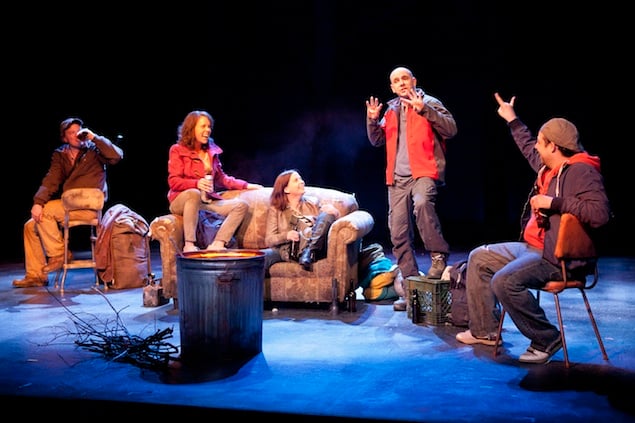Should the apocalypse ever occur, forget the carefully
curated archives at the Library of Congress or those time capsules
everyone’s mom buried in the backyard. They’ll be long gone,
leaving us with nothing but the vestiges of our fallible memories
to cling to. So instead of
Hamlet, or
Ulysses, or Picasso, we’ll be left to pass down tales of Lady Gaga, Pret à Manger, and
The Simpsons to future generations.
So says
Mr. Burns, a Post-Electric Play, currently having its world premiere run at Woolly Mammoth. In
Anne Washburn’s post-Armageddon world, survivors pass the hours by trying to recall the nuances of their favorite TV episodes. Sitting
on a dirty couch around a fire, in a manner that isn’t a million miles away from the gag sequence
The Simpsons employs in the opening credits, Matt (Steve Rosen) entertains the others with his
Homer impression while he recalls the plot of the 1993 episode “Cape
Feare” (in case you’re
not familiar with the oeuvre, it’s the one in which Sideshow
Bob plots to kill Bart in a parody of the similarly titled 1962
Robert Mitchum film).
The triviality of the discussion is entertaining enough to watch, but the characters hint that something unspeakably awful
has happened, and that danger still lurks at every corner. Jenny (Kimberly Gilbert) grasps her bag close to her, as if prepared to leave at any moment. The arrival of Gibson (Chris Genebach) breaks up the
Simpsons recapping: The five assembled onstage whip out guns and pat him down, before pulling out their lists of survivors they’ve
encountered, reciting ten names they’re each hoping for news of in what seems like a weary, pointless process.
Director
Steve Cosson is founding artistic director of
the New York documentary theater troupe the Civilians, and his
preoccupation with storytelling
shines through. Characters reveal fragments of what’s happened
to them, but the overall picture remains murky; we learn that
only around a million Americans have survived, and most nuclear
plants have been destroyed, with fatal consequences. Act two
is set seven years later, with the same motley crew of
survivors having formed a theater troupe. They rehearse an episode
of (you guessed it)
The Simpsons, complete with devised commercial
breaks—only without electricity or other mod cons, they’re forced to
improvise when it
comes to special effects (one actor ingeniously uses
chalk-covered erasers to create the effect of steam from a bubble bath).
The moral of
Mr. Burns is both heartening and dismaying: On the one
hand, people will do anything for culture, but on the other hand, it
might not
be the kind of culture you’d hope would endure, cockroach-like,
after a nuclear holocaust. The survivors cling to relics from
their former lives—from the “Three Little Maids” number from
The Mikado to the 2000 Baha Men hit “Who Let the Dogs
Out?”—and the ability to remember random things becomes a kind of
currency, with
the troupe paying different civilians for various lines of
prose. “Things aren’t funny when they’re true,” says one character
of the plays they choose to present. “They’re awful.” So they
offer
Simpsons episodes and mashups of Ricky Martin and Eminem instead.
Through a prism of pop culture references and Kelsey
Grammer impressions, Washburn reveals our primal human need for
entertainment,
as well as the hope seemingly banal works can offer. Bart’s
ability to outsmart Sideshow Bob becomes a beacon of inspiration
for those in despair, accompanied by the catchy lyrics from
“Edge of Glory.” And although the efficacy of such oral traditions
might be iffy at best, it’s a way to prove that humankind
endures, even if a hammily melodramatic reenactment of a 1993 cartoon
is the result.
Washburn, whose
Orestes, a Tragic Romp also debuted in Washington at
the Folger in 2010, has proved she has the chops to fuse high and low
culture, revealing weighty
truths through seemingly frivolous means. Cosson’s cast is
universally strong, and surprisingly adept at the song and dance
numbers. The one awkward note seems to be the costumes—in the
first scene, Gilbert sports shiny leather boots and a clean
suede jacket that seem too pristine for a refugee. But designer
Frank Labovitz shows ingenuity in his attempts to turn the cast into Homer, Marge, Bart, Lisa, and company. If culture’s all that endures
the end of times, it’s hard not to hope this show’s impact does the same.
Mr. Burns, A Post-Electric Play
is at Woolly Mammoth through July 1. Running time is two hours and 15 minutes. Tickets ($30 to $65) are available through
Woolly’s website.


















